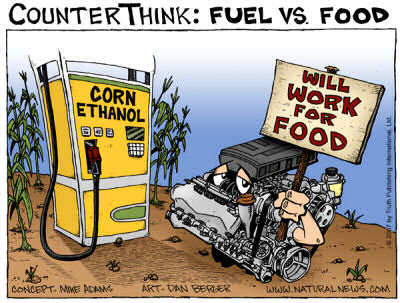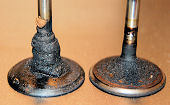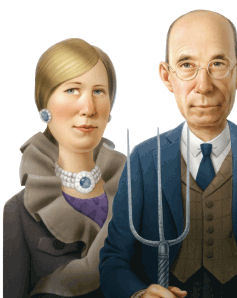Farmers' Lobby Pushing for E-15 to E-85 ASAP!
America's farmers would like to see the ethanol blend in fuel go from the E-10 that it is today, to E-15, E-30 and eventually
to E-85, just as quickly as they can plant the corn to make it happen. The fact
that it takes a gallon of gas to make a gallon of ethanol notwithstanding, powerful
forces are pushing this scenario. With a close election, and famers’ votes crucial
to both parties, don't expect much straight talk from either side about ethanol
in your future. Oddly, the groups standing between the farmers' congressional thresher
and the status quo are boaters and power equipment interests.

|
|
The farmers’ corn ethanol lobby is in full war cry. Hold on to your wallet. |
The farm lobby’s ethanol-at-any-price juggernaut is picking up steam and ironically
one of the few elements in America slowing down the madness are boat engines and
those of small power devices. The ethanol vested interests want the Environmental
Protection Agency to allow conventional cars and trucks to run on higher blends
of ethanol than now allowed. The current limit is 10 percent ethanol.

|
|
E-85 means a gallon of "gas" would be 85% ethanol. That would be very good for farmers and very bad for boat owners with current engines. |
Boat Engines Stand in the Way
But higher blends put the EPA in a bind if it can not be proved that these blends
would be ok for boats and power equipment as well as autos. This stumbling block
is driving the ethanol lobby nuts; just listen to one of their spokesmen:
"Determining automobile policy based on weed whackers is just ridiculous to me,"
said Ron Lamberty, market development director of the American Council for Ethanol.
"It's something we're going to have to deal with."
The ethanol industry is growing to a point where production will begin to saturate
the market for 10 percent ethanol, estimated to be about 13 billion gallons a year.
The industry is expected to produce nearly 10 billion gallons of ethanol this year
– up from about 5 billion gallons in 2006. An additional 3 billion gallons in production
capacity is under construction.
Under
current law, motorists are required to use 36 billion gallons of biofuels by 2022.
Putting the Brakes on Ethanol
Marine engine makers we've talked to say that marine engines can use E-10 but will
not commit to any higher ratio other than to say that use of blends higher than
E10 will void their warranties. Manufacturers of power equipment say more research
is needed before the government approves higher ethanol blends.
"We're not anti-ethanol. What we're concerned about is this transition," said Kris
Kiser, a spokesman for the Outdoor Power Equipment Institute, which represents manufacturers
such as Toro Co., Deere & Co. and Black and Decker Inc.

|
|
Corn ethanol is the best thing to happen to farmers since they were paid not to grow food. |
The California Suit is Gaining Momentum
In California, a boat owner sued several gasoline refiners, including ExxonMobil
Corp. and Chevron Corp., alleging that the ethanol added to their fuel had damaged
the fuel tanks in his old boat. Several boat owners around the country have added
their names and documentation to the suit. It is unknown how many fiberglass tanks
in old boats are degraded by E10, but all boats with glass tanks older than about
1985 are potentially at risk.
In Oregon, state lawmakers were forced this year to rewrite a law that requires
the use of ethanol in gasoline. New exemptions allow the sale of ethanol-free gas
for boats, vintage autos and power equipment.
Next year, opponents of the ethanol mandate are expected to push for full repeal.
The state marine board lists on its Internet site more than 100 places around Oregon
that sell ethanol-free gas. "We're still selling it," said Paul Kosel, who works
for Marc Nelson Oil Products, which started offering the product this spring.
"There has been so much negativity in this state in the press lately, blaming ethanol
for all kinds of things," said Brent Searle of the state agriculture department.
The public blames "everything on ethanol now. They blame a flat tire on ethanol."
Industry experts say ethanol poses three potential problems for boats: the alcohol
can eat away at old fiberglass tanks and degrade some parts in current fuel systems
in outboards, dislodge gunk and clog filters, absorb water from moist air and stop
the engine, and higher blends of ethanol may significantly reduce performance.
American Coalition for Ethanol
The "American Coalition for Ethanol" website pulls no punches in its fight to turn
American fuel into 100% ethanol. On its website it says, "...there is great potential
for using blends of ethanol between E10 and E85, and the American Coalition for
Ethanol is leading efforts to attend to any technical or regulatory hurdles in the
path of using mid-range ethanol blends like E20, E30, and E40.
"Ethanol blender pumps are key to the retailing of these fuels of the future. Used
for years to blend and dispense types of diesel fuel or grades of gasoline, blender
pumps are now being used to blend gasoline and E85 to make a variety of mid-range
blends such as 20%, 30%, or 40% ethanol."

|
|
"Oh, Clark, now we can retire early and buy a mansion in Palm Beach." |
The Problems with Ethanol for Marine Use
The energy in a gallon of E100 is 34% less than in a gallon of unleaded gasoline.
Therefore a larger volume of E100 is required -- 151.5% larger -- to equal the same
energy in a gallon of gas. This is a significant percentage loss. Sportboats, PWCs,
and ski boats with small tanks will see their range cut down drastically, even if
new engines designed for ethanol can match current performance characteristics.
Marine engines currently built are simply not designed for or intended to be used
with more than E10 and using a higher blend ratio will cause numerous problems in
addition to lack of performance. Further, EPA tests done on all 2006 automobile
models using E85 showed a 25% loss in fuel efficiency.
An Even Bigger Problem
Today the U.S. is the world's largest producer of ethanol, with Brazil placing second.
Unfortunately, the Americans are using corn to make a fuel, unlike Brazil which
is using sugar cane. Even President Bush has suggested that switchgrass would be
a better alternative.
Problem #1 is that making ethanol from corn is 5 to 6 times less
efficient than making it from sugar cane.
Problem #2 is that corn is using a basic human food to make fuel.
(Many anthropologists think that the prohibition against eating pork by the Jewish
and Muslim religions has to do with the arid conditions where those religions started
and the scarcity of human food. Pigs don't eat grass but compete for human food
stuffs like corn, fruit and vegetables. Goats and sheep eat grass and therefore
did not use up human food. Trichinosis was unknown to the ancients and was not discovered
until 1835.)

|
|
Ethanol Gothic – “Energy Policy” or “Farm Stimulus Package”? |
We would like to hear what YOU think about America's Ethanol Fiasco...please comment
below.
Ethanol Quotes to Ponder--
"Increased demand for bio-fuels... could drive up world prices for many farm
products."
--U.N. Food and Agriculture Organization
"American farmers, by making the commitment to grow more corn for ethanol, are
at the top of the spear on the war against terrorism." --former CIA
director James Woolsey
"Transforming food into fuels is a monstrosity... [It ![]() killing the poor masses
killing the poor masses
through hunger."
--Fidel Castro
"Castro was right." --The Economist
"Everything about ethanol is good, good, good." --Senator Chuck
Grassley, Iowa
"Ethanol is good for our rural communities. It's good economic development for
rural America. You know, new bio-refinery construction creates jobs and local tax
revenues. When the family farmer's doing well, it's good for the local merchants."
--George W. Bush